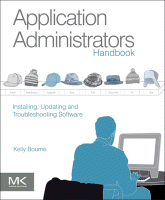Browse content
Table of contents
Actions for selected chapters
- Full text access
- Book chapterAbstract only
Chapter 1 - What Does an Application Administrator Do?
Pages 1-11 - Book chapterAbstract only
Chapter 2 - Design
Pages 12-19 - Book chapterAbstract only
Chapter 3 - Architecture
Pages 20-40 - Book chapterAbstract only
Chapter 4 - Features Common to Many Applications
Pages 41-62 - Book chapterAbstract only
Chapter 5 - Specifics About Your Application
Pages 63-77 - Book chapterAbstract only
Chapter 6 - Taking Responsibility for an Application
Pages 78-95 - Book chapterAbstract only
Chapter 7 - Change Control Management
Pages 96-111 - Book chapterAbstract only
Chapter 8 - Installing Software
Pages 112-130 - Book chapterAbstract only
Chapter 9 - Support Software
Pages 131-149 - Book chapterAbstract only
Chapter 10 - Updates and Patches
Pages 150-165 - Book chapterAbstract only
Chapter 11 - Supporting Your Application
Pages 166-183 - Book chapterAbstract only
Chapter 12 - Disaster Recovery
Pages 184-202 - Book chapterAbstract only
Chapter 13 - Handling Problems with an Application
Pages 203-218 - Book chapterAbstract only
Chapter 14 - Operational Activities
Pages 219-241 - Book chapterAbstract only
Chapter 15 - Security
Pages 242-267 - Book chapterAbstract only
Chapter 16 - The Server
Pages 268-295 - Book chapterAbstract only
Chapter 17 - Performance Tuning
Pages 296-320 - Book chapterAbstract only
Chapter 18 - The Network
Pages 321-328 - Book chapterAbstract only
Chapter 19 - Your Organization
Pages 329-343 - Book chapterAbstract only
Chapter 20 - Users
Pages 344-360 - Book chapterAbstract only
Chapter 21 - Leveraging the Vendor Relationship
Pages 361-376 - Book chapterAbstract only
Chapter 22 - The Government Gets Involved
Pages 377-386 - Book chapterAbstract only
Chapter 23 - Windows Tools
Pages 387-429 - Book chapterAbstract only
Chapter 24 - UNIX Tools
Pages 430-456 - Book chapterAbstract only
Chapter 25 - Linux Tools
Pages 457-463 - Book chapterAbstract only
Chapter 26 - Tools for Your Toolbox
Pages 464-478 - Book chapterAbstract only
Chapter 27 - Third-Party Tools
Pages 479-495 - Book chapterAbstract only
Chapter 28 - Troubleshooting Tips
Pages 496-512 - Book chapterAbstract only
Chapter 29 - Things to Do or Know How to Do in Advance
Pages 513-528 - Book chapterAbstract only
Chapter 30 - Things Will Happen That You Don’t Want to Think About
Pages 529-545 - Book chapterAbstract only
Chapter 31 - The End of Days—Decommissioning an Application
Pages 546-556 - Book chapterAbstract only
Chapter 32 - Things Every Application Administrator Should Know
Pages 557-570 - Book chapterAbstract only
Chapter 33 - Education
Pages 571-582 - Book chapterAbstract only
Chapter 34 - Parting Advice
Pages 583-590 - Book chapterNo access
Index
Pages 591-606
About the book
Description
An application administrator installs, updates, optimizes, debugs and otherwise maintains computer applications for an organization. In most cases, these applications have been licensed from a third party, but they may have been developed internally. Examples of application types include enterprise resource planning (ERP), customer resource management (CRM), and point of sale (POS), legal contract management, time tracking, accounts payable/receivable, payroll, SOX compliance tracking, budgeting, forecasting and training. In many cases, the organization is absolutely dependent that these applications be kept running. The importance of application administrators and the level to which organizations depend upon them is easily overlooked.
Application Administrators Handbook provides an overview of every phase of administering an application, from working with the vendor before installation, the installation process itself, importing data into the application, handling upgrades, working with application users to report problems, scheduling backups, automating tasks that need to be done on a repetitive schedule, and finally retiring an application. It provides detailed, hands-on instructions on how to perform many specific tasks that an application administrator must be able to handle.
An application administrator installs, updates, optimizes, debugs and otherwise maintains computer applications for an organization. In most cases, these applications have been licensed from a third party, but they may have been developed internally. Examples of application types include enterprise resource planning (ERP), customer resource management (CRM), and point of sale (POS), legal contract management, time tracking, accounts payable/receivable, payroll, SOX compliance tracking, budgeting, forecasting and training. In many cases, the organization is absolutely dependent that these applications be kept running. The importance of application administrators and the level to which organizations depend upon them is easily overlooked.
Application Administrators Handbook provides an overview of every phase of administering an application, from working with the vendor before installation, the installation process itself, importing data into the application, handling upgrades, working with application users to report problems, scheduling backups, automating tasks that need to be done on a repetitive schedule, and finally retiring an application. It provides detailed, hands-on instructions on how to perform many specific tasks that an application administrator must be able to handle.
Key Features
- Learn how to install, administer and maintain key software applications throughout the product life cycle
- Get detailed, hands-on instructions on steps that should be taken before installing or upgrading an application to ensure continuous operation
- Identify repetitive tasks and find out how they can be automated, thereby saving valuable time
- Understand the latest on government mandates and regulations, such as privacy, SOX, HIPAA, PCI, and FISMA and how to fully comply
- Learn how to install, administer and maintain key software applications throughout the product life cycle
- Get detailed, hands-on instructions on steps that should be taken before installing or upgrading an application to ensure continuous operation
- Identify repetitive tasks and find out how they can be automated, thereby saving valuable time
- Understand the latest on government mandates and regulations, such as privacy, SOX, HIPAA, PCI, and FISMA and how to fully comply
Details
ISBN
978-0-12-398545-3
Language
English
Published
2014
Copyright
Copyright © 2014 Elsevier Inc. All rights reserved.
Imprint
Morgan Kaufmann
